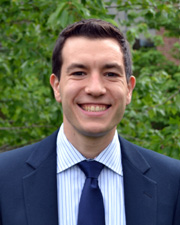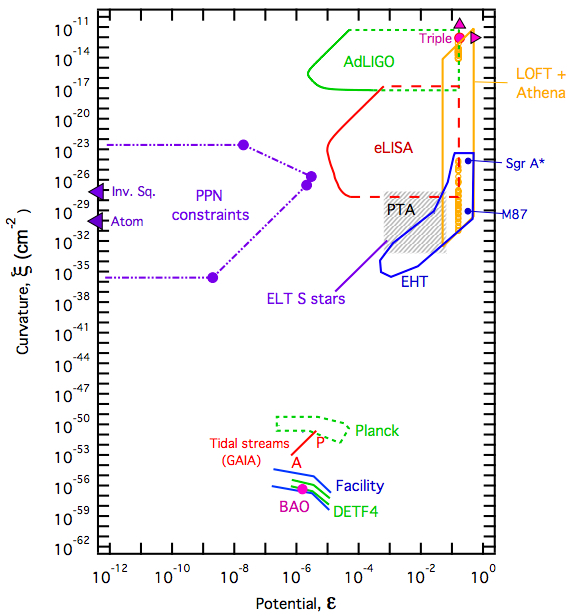Guest Post: Chip Sebens on the Many-Interacting-Worlds Approach to Quantum Mechanics
 I got to know Charles “Chip” Sebens back in 2012, when he emailed to ask if he could spend the summer at Caltech. Chip is a graduate student in the philosophy department at the University of Michigan, and like many philosophers of physics, knows the technical background behind relativity and quantum mechanics very well. Chip had funding from NSF, and I like talking to philosophers, so I said why not?
I got to know Charles “Chip” Sebens back in 2012, when he emailed to ask if he could spend the summer at Caltech. Chip is a graduate student in the philosophy department at the University of Michigan, and like many philosophers of physics, knows the technical background behind relativity and quantum mechanics very well. Chip had funding from NSF, and I like talking to philosophers, so I said why not?
We had an extremely productive summer, focusing on our different stances toward quantum mechanics. At the time I was a casual adherent of the Everett (many-worlds) formulation, but had never thought about it carefully. Chip was skeptical, in particular because he thought there were good reasons to believe that EQM should predict equal probabilities for being on any branch of the wave function, rather than the amplitude-squared probabilities of the real-world Born Rule. Fortunately, I won, although the reason I won was mostly because Chip figured out what was going on. We ended up writing a paper explaining why the Born Rule naturally emerges from EQM under some simple assumptions. Now I have graduated from being a casual adherent to a slightly more serious one.
But that doesn’t mean Everett is right, and it’s worth looking at other formulations. Chip was good enough to accept my request that he write a guest blog post about another approach that’s been in the news lately: a “Newtonian” or “Many-Interacting-Worlds” formulation of quantum mechanics, which he has helped to pioneer.
In Newtonian physics objects always have definite locations. They are never in two places at once. To determine how an object will move one simply needs to add up the various forces acting on it and from these calculate the object’s acceleration. This framework is generally taken to be inadequate for explaining the quantum behavior of subatomic particles like electrons and protons. We are told that quantum theory requires us to revise this classical picture of the world, but what picture of reality is supposed to take its place is unclear. There is little consensus on many foundational questions: Is quantum randomness fundamental or a result of our ignorance? Do electrons have well-defined properties before measurement? Is the Schrödinger equation always obeyed? Are there parallel universes?
Some of us feel that the theory is understood well enough to be getting on with. Even though we might not know what electrons are up to when no one is looking, we know how to apply the theory to make predictions for the results of experiments. Much progress has been made―observe the wonder of the standard model―without answering these foundational questions. Perhaps one day with insight gained from new physics we can return to these basic questions. I will call those with such a mindset the doers. Richard Feynman was a doer:
“It will be difficult. But the difficulty really is psychological and exists in the perpetual torment that results from your saying to yourself, ‘But how can it be like that?’ which is a reflection of uncontrolled but utterly vain desire to see it in terms of something familiar. I will not describe it in terms of an analogy with something familiar; I will simply describe it. … I think I can safely say that nobody understands quantum mechanics. … Do not keep saying to yourself, if you can possibly avoid it, ‘But how can it be like that?’ because you will get ‘down the drain’, into a blind alley from which nobody has yet escaped. Nobody knows how it can be like that.”
-Feynman, The Character of Physical Law (chapter 6, pg. 129)
In contrast to the doers, there are the dreamers. Dreamers, although they may often use the theory without worrying about its foundations, are unsatisfied with standard presentations of quantum mechanics. They want to know “how it can be like that” and have offered a variety of alternative ways of filling in the details. Doers denigrate the dreamers for being unproductive, getting lost “down the drain.” Dreamers criticize the doers for giving up on one of the central goals of physics, understanding nature, to focus exclusively on another, controlling it. But even by the lights of the doer’s primary mission―being able to make accurate predictions for a wide variety of experiments―there are reasons to dream:
“Suppose you have two theories, A and B, which look completely different psychologically, with different ideas in them and so on, but that all consequences that are computed from each are exactly the same, and both agree with experiment. … how are we going to decide which one is right? There is no way by science, because they both agree with experiment to the same extent. … However, for psychological reasons, in order to guess new theories, these two things may be very far from equivalent, because one gives a man different ideas from the other. By putting the theory in a certain kind of framework you get an idea of what to change. … Therefore psychologically we must keep all the theories in our heads, and every theoretical physicist who is any good knows six or seven different theoretical representations for exactly the same physics.”
-Feynman, The Character of Physical Law (chapter 7, pg. 168)
In the spirit of finding alternative versions of quantum mechanics―whether they agree exactly or only approximately on experimental consequences―let me describe an exciting new option which has recently been proposed by Hall, Deckert, and Wiseman (in Physical Review X) and myself (forthcoming in Philosophy of Science), receiving media attention in: Nature, New Scientist, Cosmos, Huffington Post, Huffington Post Blog, FQXi podcast… Somewhat similar ideas have been put forward by Böstrom, Schiff and Poirier, and Tipler. The new approach seeks to take seriously quantum theory’s hydrodynamic formulation which was developed by Erwin Madelung in the 1920s. Although the proposal is distinct from the many-worlds interpretation, it also involves the postulation of parallel universes. The proposed multiverse picture is not the quantum mechanics of college textbooks, but just because the theory looks so “completely different psychologically” it might aid the development of new physics or new calculational techniques (even if this radical picture of reality ultimately turns out to be incorrect).
Let’s begin with an entirely reasonable question a dreamer might ask about quantum mechanics.
“I understand water waves and sound waves. These waves are made of particles. A sound wave is a compression wave that results from particles of air bunching up in certain regions and vacating other. Waves play a central role in quantum mechanics. Is it possible to understand these waves as being made of some things?”
There are a variety of reasons to think the answer is no, but they can be overcome. In quantum mechanics, the state of a system is described by a wave function Ψ. Consider a single particle in the famous double-slit experiment. In this experiment the one particle initially passes through both slits (in its quantum way) and then at the end is observed hitting somewhere on a screen. The state of the particle is described by a wave function which assigns a complex number to each point in space at each time. The wave function is initially centered on the two slits. Then, as the particle approaches the detection screen, an interference pattern emerges; the particle behaves like a wave.

There’s a problem with thinking of the wave as made of something: the wave function assigns strange complex numbers to points in space instead of familiar real numbers. This can be resolved by focusing on |Ψ|2, the squared amplitude of the wave function, which is always a positive real number.

We normally think of |Ψ|2 as giving the probability of finding the particle somewhere. But, to entertain the dreamer’s idea about quantum waves, let’s instead think of |Ψ|2 as giving a density of particles. Whereas figure 2 is normally interpreted as showing the evolution of the probability distribution for a single particle, instead understand it as showing the distribution of a large number of particles: initially bunched up at the two slits and later spread out in bands at the detector (figure 3). Although I won’t go into the details here, we can actually understand the way that wave changes in time as resulting from interactions between these particles, from the particles pushing each other around. The Schrödinger equation, which is normally used to describe the way the wave function changes, is then viewed as consequence of this interaction.

In solving the problem about complex numbers, we’ve created two new problems: How can there really be a large number of particles if we only ever see one show up on the detector at the end? If |Ψ|2 is now telling us about densities and not probabilities, what does it have to do with probabilities?
Removing a simplification in the standard story will help. Instead of focusing on the wave function of a single particle, let’s consider all particles at once. To describe the state of a collection of particles it turns out we can’t just give each particle its own wave function. This would miss out on an important feature of quantum mechanics: entanglement. The state of one particle may be inextricably linked to the state of another. Instead of having a wave function for each particle, a single universal wave function describes the collection of particles.
The universal wave function takes as input a position for each particle as well as the time. The position of a single particle is given by a point in familiar three dimensional space. The positions of all particles can be given by a single point in a very high dimensional space, configuration space: the first three dimensions of configuration space give the position of particle 1, the next three give the position of particle 2, etc. The universal wave function Ψ assigns a complex number to each point of configuration space at each time. |Ψ|2 then assigns a positive real number to each point of configuration space (at each time). Can we understand this as a density of some things?
A single point in configuration space specifies the locations of all particles, a way all things might be arranged, a way the world might be. If there is only one world, then only one point in configuration space is special: it accurately captures where all the particles are. If there are many worlds, then many points in configuration space are special: each accurately captures where the particles are in some world. We could describe how densely packed these special points are, which regions of configuration space contain many worlds and which regions contain few. We can understand |Ψ|2 as giving the density of worlds in configuration space. This might seem radical, but it is the natural extension of the answer to the dreamer’s question depicted in figure 3.
Now that we have moved to a theory with many worlds, the first problem above can be answered: The reason that we only see one particle hit the detector in the double-slit experiment is that only one of the particles in figure 3 is in our world. When the particles hit the detection screen at the end we only see our own. The rest of the particles, though not part of our world, do interact with ours. They are responsible for the swerves in our particle’s trajectory. (Because of this feature, Hall, Deckert, and Wiseman have coined the name “Many Interacting Worlds” for the approach.)

No matter how knowledgeable and observant you are, you cannot know precisely where every single particle in the universe is located. Put another way, you don’t know where our world is located in configuration space. Since the regions of configuration space where |Ψ|2 is large have more worlds in them and more people like you wondering which world they’re in, you should expect to be in a region of configuration space where|Ψ|2 is large. (Aside: this strategy of counting each copy of oneself as equally likely is not so plausible in the old many-worlds interpretation.) Thus the connection between |Ψ|2 and probability is not a fundamental postulate of the theory, but a result of proper reasoning given this picture of reality.
There is of course much more to the story than what’s been said here. One particularly intriguing consequence of the new approach is that the three sentence characterization of Newtonian physics with which this post began is met. In that sense, this theory makes quantum mechanics look like classical physics. For this reason, in my paper I gave the theory the name “Newtonian Quantum Mechanics.”
Guest Post: Chip Sebens on the Many-Interacting-Worlds Approach to Quantum Mechanics Read More »
